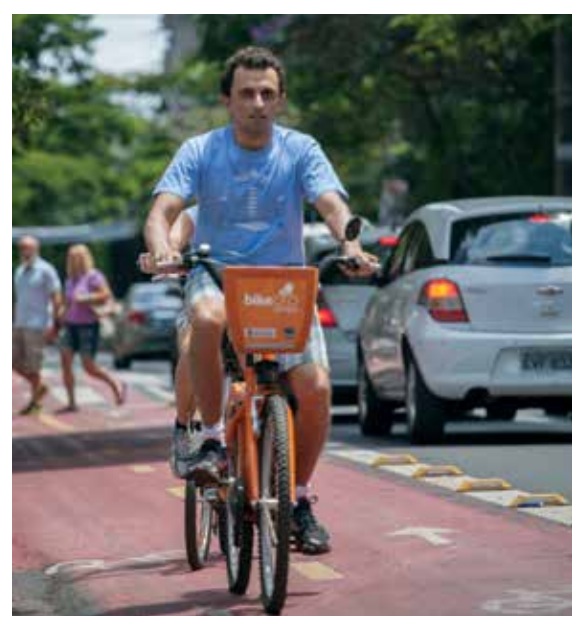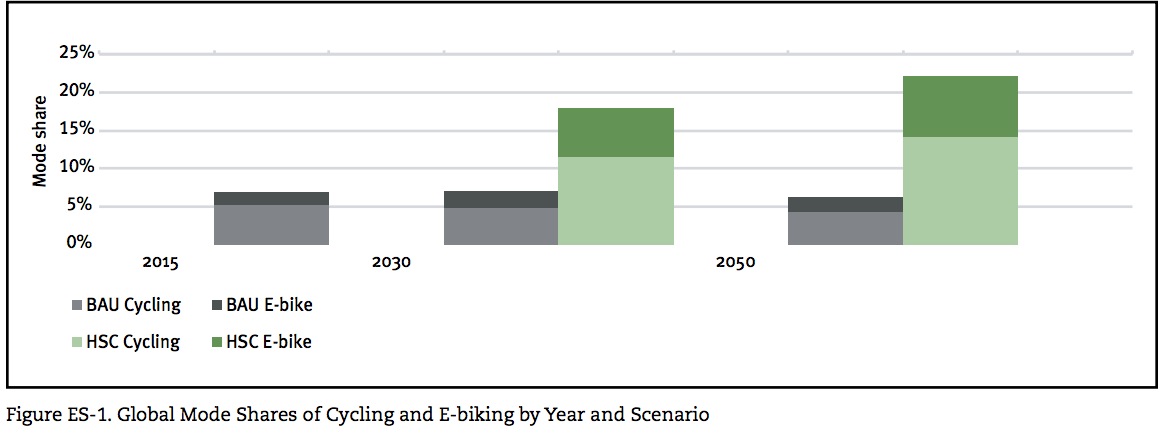INSTITUTE FOR TRANSPORTATION & DEVELOPMENT POLICY
UNIVERSITY OF CALIFORNIA, DAVIS
The Potential for Dramatically Increasing Bicycle and E-bike Use in Cities Around the World, with Estimated Energy, CO2, and Cost Impacts
Executive Summary
 Cycling plays a major role in personal mobility around the world, but it could play a much bigger role. Given the convenience, health benefits, and affordability of bicycles, they could provide a far greater proportion of urban passenger transportation, helping reduce energy use and CO2 emissions worldwide. This report presents a new look at the future of cycling for urban transportation (rather than recreation), and the potential contribution it could make to mobility as well as sustainability. The results show that a world with a dramatic increase in cycling could save society US$24 trillion cumulatively between 2015 and 2050, and cut CO2 emissions from urban passenger transport by nearly 11 percent in 2050 compared to a High Shift scenario without a strong cycling emphasis.
Cycling plays a major role in personal mobility around the world, but it could play a much bigger role. Given the convenience, health benefits, and affordability of bicycles, they could provide a far greater proportion of urban passenger transportation, helping reduce energy use and CO2 emissions worldwide. This report presents a new look at the future of cycling for urban transportation (rather than recreation), and the potential contribution it could make to mobility as well as sustainability. The results show that a world with a dramatic increase in cycling could save society US$24 trillion cumulatively between 2015 and 2050, and cut CO2 emissions from urban passenger transport by nearly 11 percent in 2050 compared to a High Shift scenario without a strong cycling emphasis.
The report builds on the 2014 study A Global High Shift Scenario: Impacts and Potential for More Public Transport, Walking, and Cycling with Lower Car Use. That report provided a global assessment of the potential for increasing travel on sustainable, efficient modes while concurrently developing cities that are far less car-dependent. However, the role of cycling in the previous study could be considered relatively minor, with the global average urban mode share increasing by three percentage points in 2030 (from 3 to 6 percent of total travel). A number of supporters/ users and contributors to the previous report felt that the role of cycling might have been understated in that study. The authors recognized that those comments might be valid because within the wider study there was limited capacity to consider cycling in detail. This report explores just how much is possible if we study cycling in more detail using the same approach. The result is the most comprehensive picture ever of global urban cycling activity.
Both the 2014 study and the High Shift Cycling Study focus on urban areas, which are projected to have the greatest growth in demand for travel. Given the higher densities of people, services, and jobs that are possible in cities, as opposed to rural areas, cities inherently have the greatest potential to direct the growing demand for travel to sustainable modes and to cycling in particular.
This study uses the same basic methodology as the previous study, including the development of business-as-usual and high shift scenarios. However, it provides a number of new contributions over the previous study.
We have:
- Undertaken a bigger effort to collect and tabulate data on cycling and electric bicycle (e-bike) ridership around the world, finding higher ridership levels than previously estimated;
- Developed better estimates of recent cycling trends by region;
- Created the new High Shift Cycling (HSC) scenario for 2030 and 2050, taking into account cities that currently have high cycling levels, typical trip distances, and other factors;
- Reestimated the potential impacts of high cycling and e-biking levels on energy use, CO2 emissions, and a range of cost factors
Cycling and E-biking: Status and Potential
The extensive data collection undertaken for this project reveals that more cities and countries than previously considered already have high cycling (and e-bike) mode shares. Based on our new database, it is estimated that in 2015 bicycles/e-bikes account for about 6 percent of urban trips worldwide. However, more than half of documented cycling trips occur in China, Japan, and a few European countries such as the Netherlands and Denmark. In the United States and Canada urban cycling is estimated to account for only about 1 percent of trips. (These values include only utility trips such as commuting or shopping— not recreational cycling.) Recent trends suggest that mode shares and cycling levels per capita are at best increasing slowly in most of the developed world, and are declining in many industrializing countries. These trends are preserved in our BAU scenario, leading to a mode share that is relatively unchanged worldwide by 2030.
Yet in considering the bigger potential for increasing cycling levels in the future, the more successful cities today can serve as models. Cities such as Amsterdam and Copenhagen are well known, though York in the United Kingdom; Davis, California; and many cities in India, China, and other countries around the world have cycling mode shares well over 15 percent of trips. Not all cities may be able to reach such levels, but there is one fact that suggests that the potential is large: in cities and countries where data is available, typically more than half of all trips are less than 10 kilometers. Even in the United States more than 35 percent of trips are less than 5 kilometers, a distance typically covered in twenty minutes or less. A number of such trips should be “cyclable” for many, or at least amenable to travel via e-bikes. The question becomes how to unlock this potential. If it can be unlocked, the benefits will be substantial.
Key Results of the New High Shift Cycling Scenario
Through a range of policies and investments described in this report, the HSC scenario achieves an 11 percent combined cycling/e-bike share of urban passenger travel distance worldwide by 2030, compared to a base share of 6 percent. By 2050 in the HSC scenario, cycling and e-bikes should account for 14 percent of urban kilometers of travel, ranging from about 25 percent in the Netherlands and China to about 11 percent in the United States and Canada. Figure ES-1 presents the mode share results for Organisation for Economic Co-operation and Development (OECD) and non-OECD countries, cycling and e-bikes, in 2015, 2030 BAU and HSC, and 2050 BAU and HSC. This shows strong increases in both OECD and non-OECD in the High Shift Cycling scenario compared to slow growth (OECD) or decline (non-OECD) in the BAU.
We have quantified three important aspects of the high shift to cycling and e-bikes: energy use, CO2 emissions, and direct costs to travelers (including vehicle purchase, operation, and related infrastructure costs). This is, however, an incomplete picture of total societal costs and benefits from increased cycling. There is a wide range of other impacts that can be expected from this scenario, many of which are difficult to quantify and have not been included in this report. Increased cycling is associated with higher rates of physical activity, reduced air pollution, lower traffic congestion, and calmer urban traffic that can reduce road-crash-related fatalities and injuries. These benefits could be investigated and quantified in follow-up research.
In summary, the increase in cycling/e-biking around the world by 2030 in the HSC scenario cuts both energy use and CO2 emissions from the entirety of urban transport by about 7 percent compared to a High Shift scenario without a strong cycling component, rising to a near 11 percent reduction by 2050. Under current trends CO2 from urban transport will soar from 2.3 gigatonnes of CO2 in 2015 to 4.3 gigatonnes by 2050. Under the HSC scenario, including the impact from increased public transport use, this figure could be cut in half, potentially resulting in a 2 gigatonnes reduction in CO2 emissions per year by 2050.
The increase in cycling and e-bike use would save the world a cumulative US$6 trillion between 2015 and 2030, increasing to US$24 trillion between 2015 and 2050. Thus a future with a dramatic increase in cycling would not only reduce CO2 emissions and energy use, but would save the world an enormous amount of money compared to a BAU future.
Download full version (PDF): A Global High Shift Cycling Scenario
About the Institute for Transportation & Development Policy
www.itdp.org
The Institute for Transportation and Development Policy works with cities worldwide to bring about transport solutions that cut greenhouse gas emissions, reduce poverty, and improve the quality of urban life.
Tags: Bicycle Product Suppliers Association, BPSA, ECF, European Cyclists’ Federation, INSTITUTE FOR TRANSPORTATION & DEVELOPMENT POLICY, ITDP, UCI, Union Cycliste Internationale, University of California Davis







 RSS Feed
RSS Feed